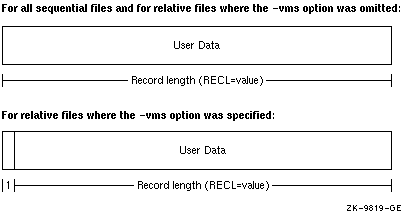
When you specify fixed-length records, all records in the file contain the same number of bytes. When you open a file that is to contain fixed-length records, you must specify the record size by using the RECL specifier. A sequentially organized file opened for direct access must contain fixed-length records, to allow the record position in the file to be computed correctly.
For relative files, the layout and overhead of fixed-length records depend on whether or not the program accessing the file was compiled with the -vms option.
For relative files where the -vms option was omitted, each record has no control information.
For relative files where the -vms option was specified, each record has one byte of control information at the beginning of the record.
The figure below shows the record layout of fixed-length records:

Variable-length records can contain any number of bytes up to a specified maximum record length, and apply only to sequential files.
Variable-length records are prefixed and suffixed by 4 bytes of control information containing length fields. The trailing length field allows a BACKSPACE request to skip back over records efficiently. The 4-byte integer value stored in each length field indicates the number of data bytes (excluding overhead bytes) in that particular variable-length record.
The character count field of a variable-length record is available when you read the record by issuing a READ statement with a Q format descriptor. You can then use the count field information to determine how many bytes should be in an I/O list.
The figure below shows the record layout of variable-length records that are less than 2 gigabytes:

For a record length greater than 2,147,483,639 bytes, the record is divided into subrecords. The subrecord can be of any length from 1 to 2,147,483,639, inclusive.
The sign bit of the leading length field indicates whether the record is continued or not. The sign bit of the trailing length field indicates the presence of a preceding subrecord. The position of the sign bit is determined by the endian format of the file.
A subrecord that is continued has a leading length field with a sign bit value of 1. The last subrecord that makes up a record has a leading length field with a sign bit value of 0. A subrecord that has a preceding subrecord has a trailing length field with a sign bit value of 1. The first subrecord that makes up a record has a trailing length field with a sign bit value of 0. If the value of the sign bit is 1, the length of the record is stored in twos-complement notation.
The figure below shows the record layout of variable-length records that are greater than 2 gigabytes:

Files written with variable-length records by Intel Fortran programs usually cannot be accessed as text files. Instead, use the Stream_LF record format for text files with records of varying length.
A segmented record is a single logical record consisting of one or more variable-length, unformatted records in a sequentially organized disk file. Unformatted data written to sequentially organized files using sequential access is stored as segmented records by default.
Segmented records are useful when you want to write exceptionally long records but cannot or do not wish to define one long variable-length record, perhaps because virtual memory limitations can prevent program execution. By using smaller, segmented records, you reduce the chance of problems caused by virtual memory limitations on systems on which the program may execute.
For disk files, the segmented record is a single logical record that consists of one or more segments. Each segment is a physical record. A segmented (logical) record can exceed the absolute maximum record length (2.14 billion bytes), but each segment (physical record) individually cannot exceed the maximum record length.
To access an unformatted sequential file that contains segmented records, specify FORM= ' UNFORMATTED ' and RECORDTYPE= ' SEGMENTED ' when you open the file.
As shown in the figure below, the layout of segmented records consists of 4 bytes of control information followed by the user data:

The control information consists of a 2-byte integer record size count (includes the two bytes used by the segment identifier), followed by a 2-byte integer segment identifier that identifies this segment as one of the following:
|
Identifier Value |
Segment Identified |
|
0 |
One of the segments between the first and last segments |
|
1 |
First segment |
|
2 |
Last segment |
|
3 |
Only segment |
If the specified record length is an odd number, the user data will be padded with a single blank (one byte), but this extra byte is not added to the 2-byte integer record size count.
A Stream file is not grouped into records and contains no control information. Stream files are used with CARRIAGECONTROL= ' NONE ' and contain character or binary data that is read or written only to the extent of the variables specified on the input or output statement.
The figure below shows the layout of a Stream file:

A Stream_CR or Stream_LF record is a variable-length record whose length is indicated by explicit record terminators embedded in the data, not by a count. These terminators are automatically added when you write records to a stream-type file and are removed when you read records.
Each variety uses a different 1-byte record terminator:
Stream_CR files use only a carriage-return as the terminator, so Stream_CR files must not contain embedded carriage-return characters.
Stream_LF files use only a line-feed (new line) as the terminator, so Stream_LF files must not contain embedded line-feed (new line) characters. This is the usual operating system text file record type.
The figure below shows the layout of Stream_CR and Stream_LF records:
